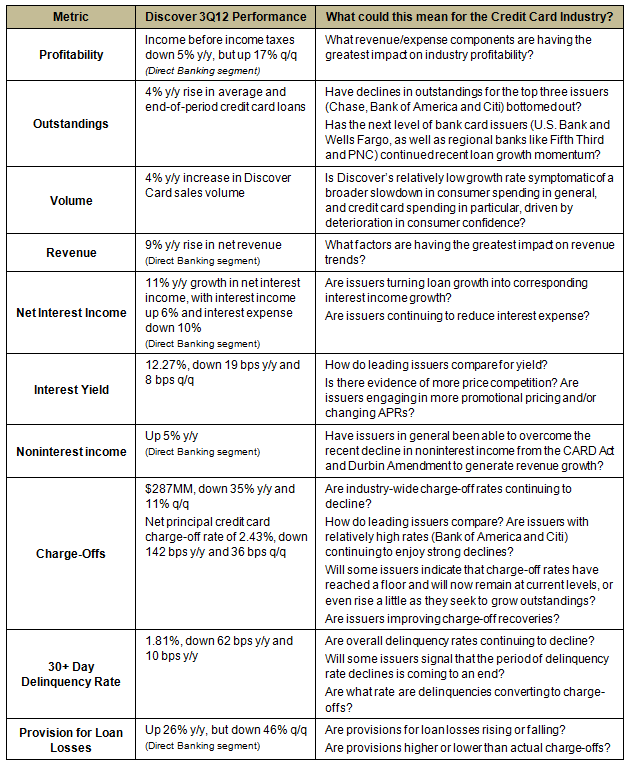Discover Financial Services reported third-quarter financials this week. As it publishes financials a few weeks before other leading card issuers, Discover’s results often act as leading indicator of broader credit card industry trends. Using Discover’s results as a benchmark, the following are 10 key credit card metrics to follow when other issuers report over the next month.
Tag Archives: revenue
Role of social media in growing bank revenues
At last month’s Financial Services Marketing Symposium, a question posted by Tim Spence of Oliver Wyman to kick off the conference reflected an issue on attendees’ minds: where does the financial services industry find revenue growth? This is top of mind in the industry, as the lower loan-loss provisions, which boosted bank profitability in 2011, are expected to tail off in 2012, so financial institutions are now looking to the revenue side of the ledger to maintain and grow profits.
According to the top 25 banks’ recent forecasts, all 25 plan to increase revenue by growing their market share – which means that some of these institutions will fail do to so.
In an environment characterized by increased competitive intensity, technological advances and renewed focus on customer relationship optimization, banks are investing in a range of new service and sales channels, with social media prominent among these emerging channels. A survey of the FSM conference audience revealed that 67% of attendees’ banks have a presence on Twitter, Facebook and LinkedIn. A recent report by FIS Global shows that many top banks have a social media presence on these three main social media platforms:
What was notable about the social media discourse at the conference is that none of the speakers explained how participation in social media channels improves revenue for their organization:
- Paul Kadin of Citibank focused on the fact that Citibank’s social media presence has helped to improve its Net Promoter Scores
- Julie Berkun Fajgenbaum of American Express OPEN discussed the organization’s social media goal: active participation by message recipients
- Tim Collins of Wells Fargo emphasized that social media is not the right channel for pushing products; rather, it is a forum for authentic, relevant messages to customers
Given the current environment, what is it about social media that allows financial institutions to justify spending resources on developing a presence in this channel? Many speakers emphasized the value of using social media in a genuine way to add value to customers’ lives; some pointed out the opportunity to make customer service more effective through social media. Perhaps the biggest opportunity of all is to differentiate a company from the pack, since no one has really figured out the “secret sauce” to financial services social media strategy – differentiation that will be crucial in the fight for market share during 2012.
For now, financial institutions see social media as an increasingly important customer service channel, and are now focusing attention on addining new social media functionality, as well as integrating social media with other channels in order to optimize relationships. Over time, as customers become more comfortable with using social media to interact with their financial institutions, opportunities to leverage social media for new customer acquisition, as well as customer cross-sell and upsell, should begin to emerge.
Growth top of the agenda in banks’ upcoming quarterly financials
Since the onset of the financial crisis in the second half of 2008, much of the coverage of banks’ quarterly financials has focused on the quality of their loan books. With key credit quality metrics starting to come under control, banks have reported profitability growth in recent quarters, with much of the profitability coming from lower provisions for loan losses. With credit quality metrics starting to return to normalized levels, the focus of attention is now starting to shift towards revenue generation (both net interest income and noninterest income).
Net interest income of course is dependent on loan growth, as well as the net interest margin. For many banks, the net interest margin has risen in recent quarters, as the deposit mix has shifted to non-interest and low-interest deposits. However, banks now also need to show evidence that of growth in their loan portfolios. Leading bank card issuers have indicated that credit card outstandings will grow in 2011. In recent quarters, banks have reported significant growth in small business loan originations (although overall small business loan portfolios continue to shrink). And banks are indicating growth in other lending categories, such as auto lending. So, for 1Q11 financials, industry experts will be looking closely at banks’ loan portfolio details to find evidence of loan growth. They will also be listening closely to bank executive statements on the prospects for loan growth for the remainder of 2011.
Industry observes will also be looking at noninterest revenue closely, focusing on overall revenue growth, composition of noninterest revenue and statements by bank executives on their plans to accelerate noninterest revenue growth in the coming quarters.

